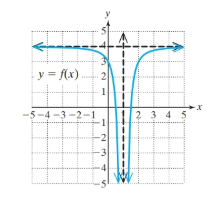
For Exercises 13–16, refer to the graph of the function and complete the statement. (See Example 1)
a. As
____________.
b. As
____________.
c. As
______________.
d. As
_____________.
e. The graph is increasing over the interval(s) _________.
f. The graph is decreasing over the interval(s) __________.
g. The domain is _____________.
h. The range is _________.
i. The vertical asymptote is the line ___________.
j. The horizontal asymptote the line ____________.

Want to see the full answer?
Check out a sample textbook solution
Chapter 3 Solutions
College Algebra with Corequisite Support
- 7) Use the Venn Diagram below to determine the sets A, B, and U. A = B = U = Blue Orange white Yellow Black Pink Purple green Grey brown Uarrow_forward8) Use the Venn diagram provided to shade An Bº. A B U Darrow_forward5) Describe the difference between disjoint sets and overlapping sets.arrow_forward
- 12) Suppose U = {a,b,c,d,e) and A = {a, b, c, e) and B = (c,d,e). Determine (An B).arrow_forward1) Use the roster method to list the elements of the set consisting of: a) All positive multiples of 3 that are less than 20. b) Nothing (An empty set).arrow_forward2) Let M = {all postive integers), N = {0,1,2,3... 100), 0= {100,200,300,400,500). Determine if the following statements are true or false and explain your reasoning. a) NCM b) 0 C M c) O and N have at least one element in common d) O≤ N e) o≤o 1arrow_forward
- 4) Which of the following universal sets has W = {12,79, 44, 18) as a subset? Choose one. a) T = {12,9,76,333, 44, 99, 1000, 2} b) V = {44,76, 12, 99, 18,900,79,2} c) Y = {76,90, 800, 44, 99, 55, 22} d) x = {79,66,71, 4, 18, 22,99,2}arrow_forward3) What is the universal set that contains all possible integers from 1 to 8 inclusive? Choose one. a) A = {1, 1.5, 2, 2.5, 3, 3.5, 4, 4.5, 5, 5.5, 6, 6.5, 7, 7.5, 8} b) B={-1,0,1,2,3,4,5,6,7,8} c) C={1,2,3,4,5,6,7,8} d) D = {0,1,2,3,4,5,6,7,8}arrow_forward5) 8.4 6.3 ?arrow_forward
- Wendy is looking over some data regarding the strength, measured in Pascals (Pa), of some rope and how the strength relates to the number of woven strands in the rope. The data are represented by the exponential function f(x) = 2x, where x is the number of woven strands. Explain how she can convert this equation to a logarithmic function when strength is 256 Pascals. Please type out answerarrow_forwardHarrison and Sherrie are making decisions about their bank accounts. Harrison wants to deposit $200 as a principal amount, with an interest of 2% compounded quarterly. Sherrie wants to deposit $200 as the principal amount, with an interest of 4% compounded monthly. Explain which method results in more money after 2 years. Show all work. Please type out answerarrow_forwardMike is working on solving the exponential equation 37x = 12; however, he is not quite sure where to start. Solve the equation and use complete sentences to describe the steps to solve. Hint: Use the change of base formula: log y = log y log barrow_forward
- Algebra & Trigonometry with Analytic GeometryAlgebraISBN:9781133382119Author:SwokowskiPublisher:Cengage
